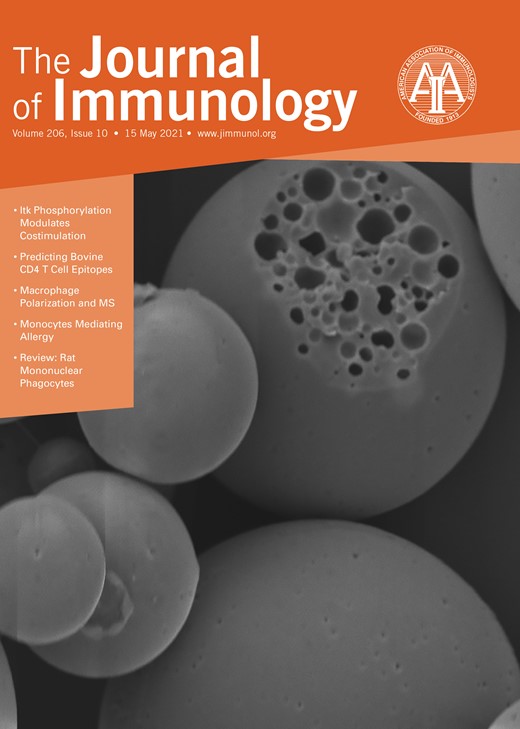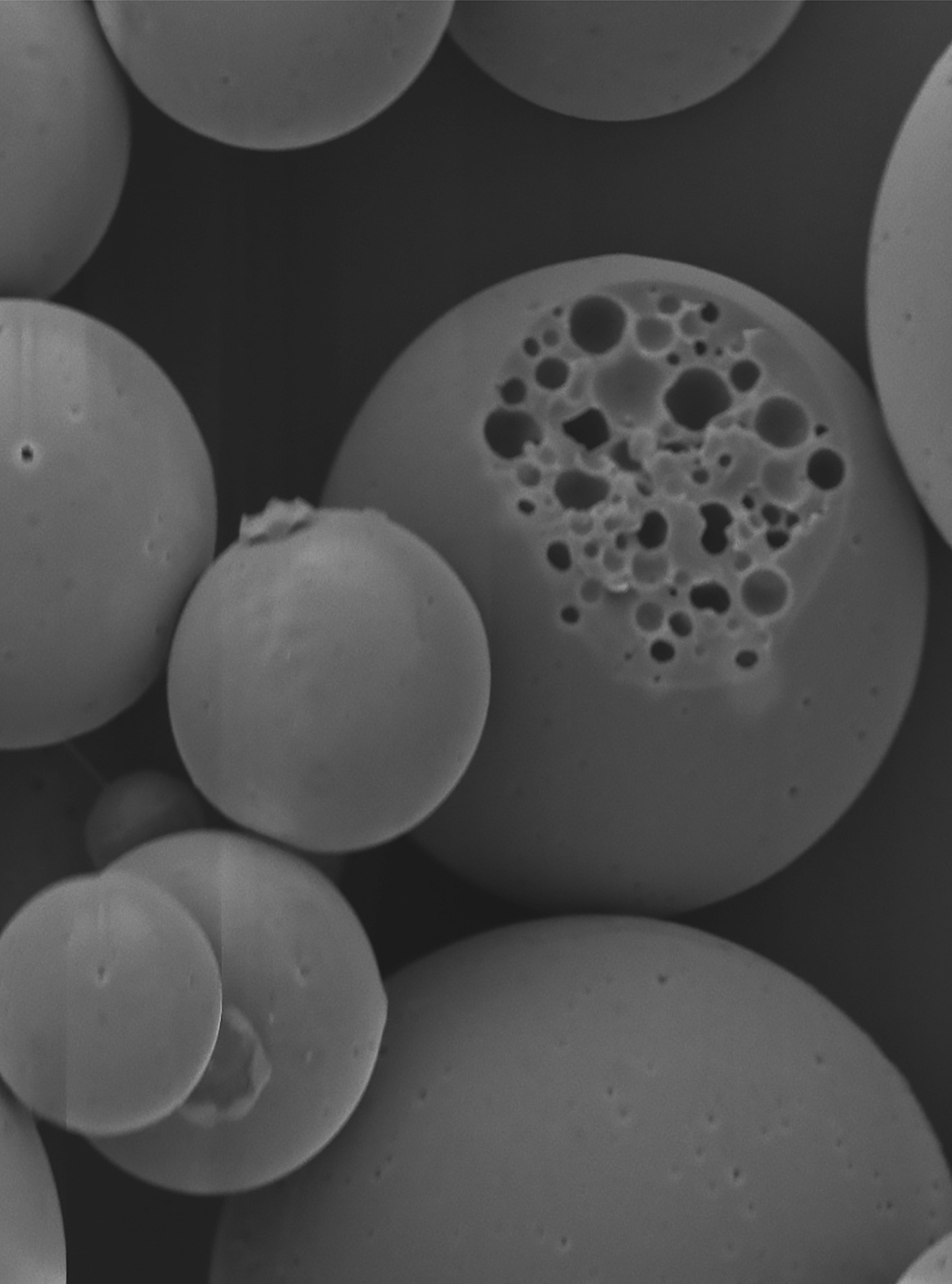
Cover image

On the cover: Poly(lactic-coglycolic) acid microparticles (MP) encapsulating anti-IL-17A Abs. MP were fabricated as a sustained delivery system to treat murine periodontitis. Characterization of the MP surface morphology was carried out using a scanning electron microscope (JSM-6330F; JEOL). The image (×5500) shows spherically shaped MPs with an average diameter of 17.8 mm. Pacheco, C. M. F., K. L. M. Maltos, M. S. Shehabeldin, L. L. Thomas, Z. Zhuang, S. Yoshizawa, K. Verdelis, S. L. Gaffen, G. P. Garlet, S. R. Little, and C. Sfeir. 2021. Local sustained delivery of anti-IL-17A antibodies limits inflammatory bone loss in murine experimental periodontitis. J. Immunol. 206: 2386–2392.
Volume 206, Issue 10, May 2021
Top Reads
Top Reads
Brief Reviews
The Mononuclear Phagocyte System of the Rat
Cutting Edge
Cutting Edge: mTORC1 Inhibition in Metastatic Breast Cancer Patients Negatively Affects Peripheral NK Cell Maturation and Number
Everolimus treatment inhibits mTORC1 activity in human peripheral NK cells.
This decreases the circulating NK cell number and impairs NK cell homeostasis.
However, NK cell effector functions are conserved upon everolimus treatment.
Cutting Edge: TCR-β Selection Is Required at the CD4+CD8+ Stage of Human T Cell Development
Human RAG2-deficient developing T cells progress up to the CD4+CD8+ stage.
TCR β selection of human CD4+CD8+ cells allows for their survival/proliferation.
Allergy and Other Hypersensitivities
MYO1F Regulates IgE and MRGPRX2-Dependent Mast Cell Exocytosis
MYO1F regulates IgE and MRGPRX2-dependent mast cell degranulation.
MYO1F regulates actin cytoskeleton dynamics and distribution of secretory granules.
MYO1F is required for mitochondria fission and location in activated mast cells.
Nanoparticles Displaying Allergen and Siglec-8 Ligands Suppress IgE-FcεRI–Mediated Anaphylaxis and Desensitize Mast Cells to Subsequent Antigen Challenge
Enforced recruitment of Siglec-8 to the IgE–FcεRI complex suppresses anaphylaxis.
Antigenic particles with Siglec-8 ligand desensitize mast cells to allergen challenge.
Na+/H+ Exchanger Regulatory Factor 1 Mediates the Pathogenesis of Airway Inflammation in a Murine Model of House Dust Mite–Induced Asthma
NHERF1 promotes airway inflammation and goblet cell hyperplasia in asthma.
NHERF1 regulates the expression of proinflammatory mediators in asthma pathogenesis.
IgE-Binding Monocytes Have an Enhanced Ability to Produce IL-8 (CXCL8) in Animals with Naturally Occurring Allergy
A novel mAb identifies a role for IL-8 in IgE-mediated allergy.
IgE cross-linking induces IL-8 production in IgE-binding monocytes and basophils.
Allergic horses have higher IL-8+/IgE+ monocyte percentages after IgE cross-linking.
Antigen Recognition and Responses
Itk Promotes the Integration of TCR and CD28 Costimulation through Its Direct Substrates SLP-76 and Gads
TCR-induced, Itk-mediated phosphorylation of Gads Y45 occurs within the LAT complex.
SLP-76 Y173 is phosphorylated by Itk and required for RE/AP transcriptional activity.
Nonphosphorylated, monomeric Gads selectively inhibits the activation of RE/AP.
Autoimmunity
Lipid Receptor G2A-Mediated Signal Pathway Plays a Critical Role in Inflammatory Response by Promoting Classical Macrophage Activation
Lp-PLA2 inhibition leads to M2 polarization and an ameliorated EAE.
lysoPC mediates the effect of Lp-PLA2 on M1 macrophage polarization in EAE.
Lp-PLA2 and lysoPC affect macrophages by activating STAT5 and IRF5 through G2A.
Identification of a Long Noncoding RNA TRAF3IP2-AS1 as Key Regulator of IL-17 Signaling through the SRSF10–IRF1–Act1 Axis in Autoimmune Diseases
lncRNA TRAF3IP2-AS1 is a negative regulator of IL-17 signaling.
TRAF3IP2-AS1 functions by recruiting SRSF10 protein.
TRAF3IP2-AS1 and SRSF10 are potential targets for the treatment of MS/psoriasis.
Clinical and Human Immunology
SKP2-Promoted Ubiquitination of FOXO3 Promotes the Development of Asthma
SKP2 is highly expressed in patients with asthma and in OVA-induced asthmatic rats.
SKP2 enhances airway hyperresponsiveness and inflammation in the OVA-induced rat model.
SKP2 promotes the ubiquitination of FOXO3 in ASMCs.
Immune Regulation
Ubc13 Promotes K63-Linked Polyubiquitination of NLRP3 to Activate Inflammasome
Ubc13 mediates K63-linked polyubiquitination of NLRP3.
K63-linked polyubiquitination of NLRP3 accelerates NLRP3 inflammasome assembly.
Local Sustained Delivery of Anti–IL-17A Antibodies Limits Inflammatory Bone Loss in Murine Experimental Periodontitis
We developed a local sustained release system for targeting the IL-17A cytokine in vivo.
Local sustained delivery of anti–IL-17A inhibited murine inflammatory bone loss.
Comparative Analysis of Antigen-Specific Anti–SARS-CoV-2 Antibody Isotypes in COVID-19 Patients
Ab responses in COVID-19 patients differ among Ags and their isotypes.
IgG against RBD best correlates with virus-neutralizing activity and disease severity.
Immunotherapy and Vaccines
Impact of HIV-1 Infection and Antigen Class on T Follicular Helper Cell Responses to Pneumococcal Polysaccharide–Protein Conjugate Vaccine-13
HIV-infected and control adults show similar B cell response to PPS in PCV-13 vaccine.
B cell responses and Abs to DT protein are lower in persons with HIV infection.
Impaired B cell responses to DT with HIV are associated with lower ICOS+ Tfh cells.
Infectious Disease and Host Response
Tumor-Specific T Cells Exacerbate Mortality and Immune Dysregulation during Sepsis
Tumor-specific CD8+ T cells worsen mortality in a mouse model of polymicrobial sepsis.
This effect is linked to increased apoptosis of non–tumor-specific CD8+ T cells.
This is linked to increased expression of 2B4 on non–tumor-specific CD8+ T cells.
Transglutaminase 2 Regulates Innate Immunity by Modulating the STING/TBK1/IRF3 Axis
TG2 negatively regulates TBK1–IRF3 interaction limiting IFN-β response.
TG2 expression is correlated to IFN-β response in COVID-19 pathogenesis.
Lower IL-7 Receptor Expression of Monocytes Impairs Antimycobacterial Effector Functions in Patients with Tuberculosis
Decreased IL-7 receptor expression of monocytes from tuberculosis patients occurred.
Impaired IL-7 response of monocytes in M. tuberculosis infection occurred.
IL-7 promotes mycobacterial killing by macrophages in vitro.
Innate Immunity and Inflammation
Dietary Fiber Drives IL-1β–Dependent Peritonitis Induced by Bacteroides fragilis via Activation of the NLRP3 Inflammasome
Dietary fiber, but not B. fragilis, induces IL-1β secretion through NLRP3 activation.
The NLRP3–ASC–caspase-1–IL-1R axis contributes to peritonitis and abscess development.
G3BP1 Inhibition Alleviates Intracellular Nucleic Acid–Induced Autoimmune Responses
G3BP1 deletion dampens the intracellular nucleic acid sensing.
G3BP1 inhibition alleviates nucleic acid–induced immune responses.
RSVL is effective in treating nucleic acid–induced autoimmune responses.
Tumor Immunology
The Role of IgM Antibodies in T Cell Lymphoma Protection in a Novel Model Resembling Anaplastic Large Cell Lymphoma
AID–/–MRL/lpr mice without secreted Abs do not develop autoimmunity.
Unlike IgM+/+AID–/–MRL/lpr mice, Ab-lacking mice developed high-grade lymphoma.
Lymphoma severity was reduced in p53–/– mice receiving IgM autoantibodies.
HE4 Overexpression by Ovarian Cancer Promotes a Suppressive Tumor Immune Microenvironment and Enhanced Tumor and Macrophage PD-L1 Expression
In human ovarian cancer, high HE4 is associated with a suppressive immune niche.
HE4 results in more M2 macrophages and less activated CTLs in malignant ascites.
High HE4 alters the cytokine makeup of ascites towards myeloid-recruiting factors.
Novel Immunological Methods
Integral Use of Immunopeptidomics and Immunoinformatics for the Characterization of Antigen Presentation and Rational Identification of BoLA-DR–Presented Peptides and Epitopes
MS immunopeptidomics and motif are characterized for seven prevalent BoLA-DRB3 molecules.
NetBoLAIIpan is a pan-specific predictor for BoLA-DRB3 Ag presentation.
NetBoLAIIpan demonstrated unprecedented CD4 T cell epitope prediction performance.


